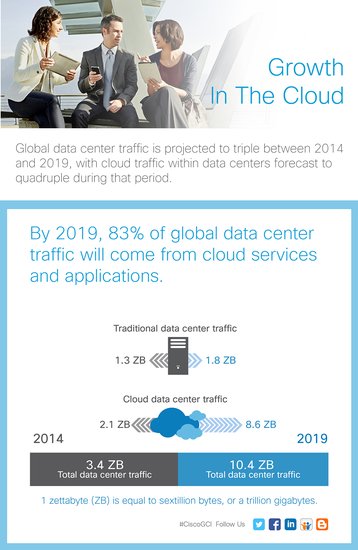Research from Cisco suggests that the amount of traffic flowing through data centers worldwide will more than triple between 2014 and 2019, reaching 10.4 zettabytes (ZB) per year. That’s equivalent to 26 months of continuous music streaming for every person on the planet, taking population increase into account.
According to the latest Global Cloud Index, public and private clouds will account for 80 percent of the growth in data center traffic, which will increase from 2.1 ZB in 2014 to 8.6 ZB in 2019. Traditional workloads will grow at a much slower pace, from 1.3 ZB in 2014 to 1.8 ZB in 2019.
“The Global Cloud Index highlights the fact that cloud is moving well beyond a regional trend to becoming a mainstream solution globally, with cloud traffic expected to grow more than 30 percent in every worldwide region over the next five years,” said Doug Webster, vice president of service provider marketing at Cisco.
“Enterprise and government organizations are moving from test cloud environments to trusting clouds with their mission-critical workloads. At the same time, consumers continue to expect on-demand, anytime access to their content and services nearly everywhere. This creates a tremendous opportunity for cloud operators, which will play an increasingly relevant role in the communications industry ecosystem.”
Cloudy with a chance of more cloud
Cisco forecasts that the adoption of public infrastructure from providers like AWS, Azure and SoftLayer will far surpass the adoption of private clouds. Public cloud workloads will grow by 44 percent while private cloud workloads will grow just 16 percent between 2014 and 2019.
By 2019, North America will have the highest cloud traffic volume (3.6 ZB), followed by Asia Pacific (2.3 ZB) and Western Europe (1.5 ZB) regions.
According to the Cloud Index, the factors driving greater cloud adoption include the rise in number of consumer devices that rely on cloud storage, and the growth of the Internet of Things, which Cisco now refers to as the Internet of Everything (IoE).
The company predicts that by 2019, IoE applications will generate around 507.5 ZB of data per year -that’s 49 times greater than the projected data center traffic for the same year.
Software-as-a-Service will be the most popular and adopted service model for cloud workloads in 2019, with 59 percent of the total cloud workloads being SaaS. Infrastructure-as-a-Service will account for 30 percent of cloud traffic, down from 42 percent in 2014. Platform-as-a-Service (PaaS) will also decrease in popularity, going from 13 percent in 2014 to 11 percent in 2019.
The number of workloads per physical server will have to increase to support the growth in traffic. Cloud data center workload density is expected to go from 5.1 in 2014 to 8.4 by 2019. Meanwhile traditional data centers will increase their workload density from 2.0 in 2014 to 3.2 by 2019.

